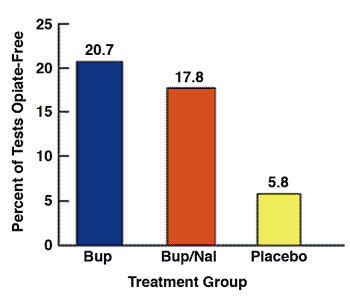What Buprenorphine is and Why It's Important
 Buprenorphine and Buprenorphine/Naloxone Help Patients Quit Opiate Abuse Fudala, et al. New England J Medicine 349(10):949-958, 2003.
Buprenorphine and Buprenorphine/Naloxone Help Patients Quit Opiate Abuse Fudala, et al. New England J Medicine 349(10):949-958, 2003.- NIDA supported basic and clinical research led to the development of buprenorphine, a medication for the treatment of heroin addiction.
- These scientific discoveries spurred a collaboration with industry, which culminated in FDA approval of Subutex® (buprenorphine) and Suboxone® tablets (buprenorphine/ naloxone) in October 2002.
- Buprenorphine is a long-acting partial mu opiate agonist that acts on the receptor targets of heroin and morphine, but does not produce the same intense "high" or dangerous side effects. These properties also make it a good potential treatment for addiction to opiate analgesics.
- Buprenorphine's unique formulation with naloxone, an opioid antagonist (Suboxone), limits diversion by causing severe withdrawal symptoms in those who inject it to get "high", but no adverse effects when taken orally (naloxone is minimally absorbed when taken orally). This exemplifies the feasibility of developing strategies that minimize the diversion liability of opiate medications.
- A large NIDA-sponsored multisite clinical trial demonstrated a robust effect in reducing opiate use and drug cravings in heroin abusers and confirmed its safety and acceptability (figure).
- Along with methadone, buprenorphine has helped curb the spread of HIV that occurs through injection drug use in this country.
Changing the Culture of Drug Abuse Treatment
- In 2000, Congress passed the Drug Addiction Treatment Act, allowing qualified physicians to prescribe narcotic medications (Schedules III to V) for the treatment of opioid addiction. This created a major paradigm shift that allowed access to heroin treatment in a medical setting rather than limiting it to methadone clinics.
- Buprenorphine has also helped change the mindset of many community treatment providers in this country, who for the most part have been unwilling to consider the use of medications to treat drug addiction. Some of these programs now use buprenorphine to assist in opiate detoxification.
What We Are Doing Now
-
We continue to test the safety and efficacy of buprenorphine in other affected populations, including pregnant women, adolescents, and patients addicted to opiate analgesics.
-
We are striving to increase the use of this and other addiction medications in other settings and countries, including in the U.S. criminal justice system and in countries where injection drug use is still a primary mode of HIV transmission.
